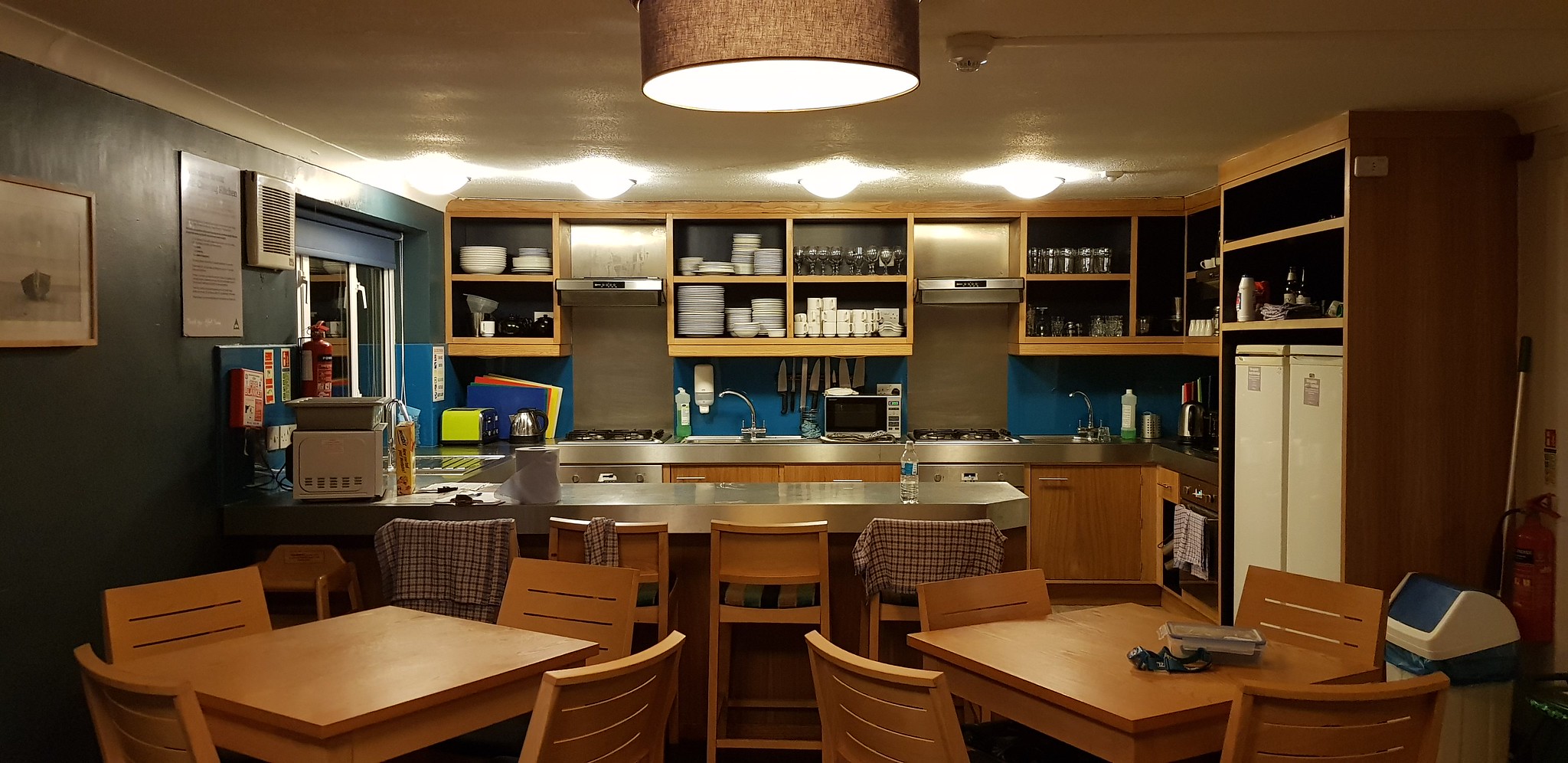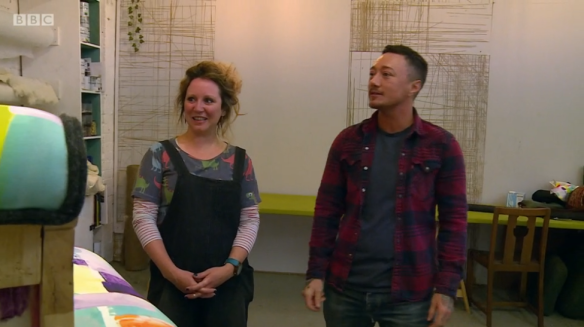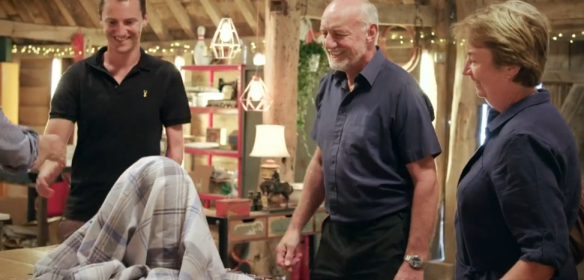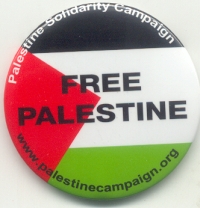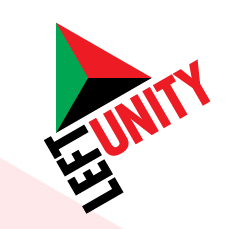Early in June we took a walk of about 130 miles along the North Cornwall coast and into West Devon.
Our camera packed up after a rainy spell on the coast path last year and hasn’t yet been replaced, so this is a slightly idiosyncratic account intended to jog my memory rather than amuse you.
Though we do have lizards and scientologists, so give it a go.
And sunsets.

Bude at dusk, from the lock gates, early June
Also, I found the Vegan Cornwall blog useful in planning where to eat, although my experience was sometimes different.
Day 1 – St Ives to Hayle
8 miles after the long train journey down – above Carbis Bay and then through the dunes between Porth Kidney Sands and the branch line from St Erth. In the garden of The Badger Inn at Lelant Saltings we watch a seagull finish off an abandoned lunch, even venturing the ketchup. Reach Hayle – Hayle is the old Cornish word for, simply, estuary but confusingly the river itself is also called the Hayle. Then again, Ordnance Survey maps rarely name the brief watercourses which nevertheless manage to open out significant coves and even bays, so no complaints. Hayle’s infrastructure reveals its past as a major port and steam engine producer. Treglisson campsite is a good place less than 2 quiet miles’ walk out of Hayle with outside and covered play spaces for kids, Pirate FM piped into the washrooms, and run by very nice former teacher. Walk back into Hayle, buy breakfast and lunch from the Co-op, then to the Curry Leaf for a very good chana masala and saag bhaji with views over construction work on the estuary, followed by a pint at the Cornish Arms. Local papers full of remarkable misdemeanours (e.g. leisure centre worker poisons colleague’s lunch with chlorine) and nearly-broken record performance of Pirates of Penzance. Letters pages full of UKIP support. Walk back at dusk, head torches off, buzzed by bats.
Day 2 – Hayle to Portreath
Early awakening by extremely loud dawn chorus – a pattern repeated for the week. Sunny, the dewy tent soon dries. Breakfast is half a rhubarb pie, and we put the lunch we bought the previous night into our lunchboxes. We tell ourselves if the campsite owner repeats his offer of a ride down to the coast we will accept. He drops us off north of the holiday parks around 10. Some miles along, a coffee at Godrevy Beach Cafe. They have very nice vegan-looking salads, but we already have lunch which we eat sitting on a sandy bank in a car park above dunes with a gymkhana going on in the background. After that we’re into the UNESCO World Heritage mining district. Portreath used to be an important port for Cornwall’s metal mining industry whose centres were inland at Camborne and Redruth. We have a drink at the Waterfront Inn with views of the beach. There’s a lot of litter and dog crap around, which I assume was left by the half term week tourists. About two miles down the mineral tramway route from Portreath, Cambrose Touring Park is a very well-kept place run by a former dairy farmer and remarkable for fully adjustable, unlimited showers. Also there, two dutch gents passing the first night of their cycle from Lands End to John O’Groats. Once again the owner offers us a lift into Portreath to find dinner. He recommended Basset Arms – nice place but I didn’t find them very active in the vegan department. I had to have chips and salad. The Bassets were a family of mineral lords – mine owners whose wealth dates back to their arrival during the Norman conquest – Cornish separatists and UKIP voters might like to think about that when they celebrate Cornwall’s former industrial prowess. We have another drink in the Basset sun room listening to a young woman talk about her new job in a shop in Penzance, then back along the tramway at dusk with more bats and dog walkers.
Day 3 – Portreath to Perranporth
Overcast but tent dries. Breakfast is odd – falafel and cherry tomato purchased the day before yesterday at Hayle Co-op. Rather than walking down the tramway again we pick up the path north of Portreath and soon arrive at Porthtowan where we impulsively buy some jam tarts (odd choices of food indicate restricted vegan offerings before happening upon the beach cafe where I’m briefly lit up by the prospect of veggie bacon – only to discover it’s Quorn, which is owned by a private equity firm and made of a patented fungus held together with egg albumen. Quorn is more for dieters than serious vegetarians but unfortunately it seems to have taken Cornwall by storm. Over my beans on toast I read the cafe copy of a history of Porthtowan. The village was once a busy resort for the people of Redruth. From Porthtowan (‘towan’ is the Cornish word for dune, and ‘porth’ means cove) we head through the mining centre of St Agnes Head, lunching on refined mezze at the Driftwood Spars pub at Trevaunance Cove and eventually reaching Tollgate Farm, a nice campsite accessed via a mile or so of good footpath from Perranporth through the golf course. It is home to many rabbits. After showering we set off back to Perranporth for dinner at the Jaipur and our customary Co-op shop for next day’s breakfast and lunch. Hoping to reach the beach through the golf course we become disorientated among the sand dunes, have to divert away from MOD land and end up back on the coast path, reaching Perranporth beach 3 miles later in light rain. About 15 or 20 wetsuited surfers are in the sea and among the astonishing amount of rubbish on the beach is a jellyfish about a metre in diameter (barrel?). The beach flotsam (and possibly jetsam) is a mixture of plastic stuff that looks as if it has been around the world a few times and packaging dropped by beach users, and it makes the beach look dismal. It’s no surprise that Surfers Against Sewage – co-founded by Porthtowan and St Agnes people, incidentally – have diversified into several campaigns against marine litter including posting identifiable litter back to manufacturers and trying to get people to stop flushing discarded plastics down the toilet. The Jaipur was high quality – another saag bhaji and chana masala. Back to the campsite at dusk with only one wrong turn on the golf course.
Day 4 – Perranporth to Newquay
Breakfast is apple pie and jam tarts – too much even for my sweet tooth but bringing a flare of energy as we paddle the two miles along a largely deserted Perran Sands before scrambling up the dune and onto the cliffs and round a strange razor wire-festooned army base before descending to Holywell Bay and St Piran’s Inn (which has an old fashioned glass water cooler with a brass tap). Then we trudge through the dunes, losing the waymarks, abraded by marram grass which stabilises the dunes, and generally exhausting ourselves. It is warm but blisters have kept Matt out of his sandals – neither New Skin nor plasters stay in place. We meet a couple of Australian pensioners striding lustily in the other direction who recommend leukotape sports strapping tape over a bit of padding. We walk along The Gannel for a while and since tide is low we cross at the footbridge and stop at the hut on the other side for lemonade lollies. Then through Crantock along the river’s edge and to Trenance Holiday Park whose permanent residents have developed their static caravans with landscaping and boundary walls. Most strikingly, a small conservatory with tiny arches through which a model railway runs in from the yard beyond. We put up our tent within earshot of the school behind. That evening we head to The Fort on Fore Street and watch surfers from a beer garden strung with wire to deter seagulls (though not choughs). We also saw some gigs – gig racing is an internationally growing sport at which Cornwall excels. We’re celebrating tonight and after surveying Newquay for vegan-friendly foods we settle on Pizza Express with its NUS discount (I’m a legit but dubious holder of an NUS card) sea views and new Pianta vegan pizza.
Day 5 – Newquay to Porthcothan
We have a long shopping list at Newquay: sports strapping tape from Boots; Ordnance Survey map from Tourist Information; batteries for Matt’s GPS (which he sets to beep on arrival at various critical places mainly to keep us to time) and a pasty for lunch. Tourist Information tells us we can get a vegan pasty at a certain place but it turns us away – we are served by (we think) Jamie’s Pasty Parlour on Central Square near Fore Street. The woman warns us they will be paler in colour and it occurs to us that perhaps the only reason the vegetable pasties are not vegan is the stupid wasteful cosmetic egg wash. Cafe Irie opens at 10am and we have an enormous cooked breakfast with a vegan option which doesn’t involve just leaving things out. We set off relatively late and it takes a while to reach the edge of Newquay’s suburbs, and a heavy rain shower sent us sheltering under a new apartment complex to put on our coats and pack covers. The shower soon passes and we watch five kitesurfers on Watergate Bay in bright sunlight. We reached Mawgan Porth at lunchtime but our breakfast is still going down so we only had a pint at the Merrymoor. It’s Wednesday in early June and the diners seem to be mostly pensioners who stare intently through the windows as we change back into our waterproofs – trousers this time – on the steps outside. The sky opens up and for two hours we drip our way up and down the cliffs with almost no visibility of the Bedruthan Steps. The sky clears. A couple of walkers coming from the other direction report large hailstones. Slowly drying out, we sit down in a deserted cove at about 3pm to eat our pasties. Behind us is an abandoned car. A spaniel arrives followed by a man who walks laboriously and we exchange a few friendly words. Another car arrives, another old geezer gets out, and to our mystifcation they both get into the abandoned car. We continue, eventually turning into the mouth of the (unnamed) river at Porthcothan. It’s amazing to me how such puny rivers carve out such magnificent passages to the sea – though Matt reminds me that they could be glacial. A new two-storey house on the cliff has eliminated most of the wall on its river-facing side, which has become four large windows. Its prospect is a sandy beach and a trickle backed by a round grassy hill, and it’s almost inconceivable that in 6 hours the tide will have altered the scene beyond recognition. I find these changing views very exciting. Carnevas campsite is a very nice place but there are recklessly fast drivers on the lane. It’s windy when we arrive so we shield our tent with a hedge and an unoccupied motorhome, but suddenly the wind drops at about the time the tide is changing. There is a lot to know about wind and tide but I can’t find anything about tides causing wind changes. Carnevas has a bar and they make chips and salad for me and vegetable lasagne for Matt. I should say that the progress of vegetarianism is very strong in Cornwall, so I tell myself that even though veganism seems to mystify the Cornish hospitality industry there is every hope that in 20 years they will have grasped it. It needn’t be costly of time or money.
Day 6 Porthcothan to Padstow
Breakfast is at the next campsite along, Berryfields. It is run by a nice family from the Midlands (Cornwall and Devon are full of Midland people). Despite their sign, they seem surprised by breakfasters but the dad rises to the occasion and fires up the kitchen while we sit in the sunny pleasantly planted courtyard. Good humouredly anti-vegetarian, Mr Bellisan butters my toast by mistake and ends up with a second breakfast himself. We chat about the problems of large single sex groups of campers, which has led him to specify the easily decoded “Camping for nice people”. Thanks to Tripadvisor, Berrylands is renowned for their cream teas, and he hopes to major on those. One son goes off to the Royal Cornwall Show and the other, an electrician, talks to us for a while about veganism. Father and son debate whether Stein or Chip Ahoy have better fish and chips in Padstow. We set off, reaching the attractive Treyarnon Bay youth hostel in the late morning. I’m not sure why the staff (who reminded me of Bill and Ted) felt unauthorised to divert some houmous from the menu into a packed lunch for me, but there you go. Then up and down the cliffs to Trevone, too late for the beach cafe but I have pasta and sundried tomato sauce with salad at the Well Parc Hotel, a friendly, spacious place with a lot of potential. Matt has a ploughmans with probably 500g of cheese. We reach Trevose Head and the turn along the Camel (a river with a name) very tired and footsore with 4 miles to go. More dunes after gun point, then down along the Camel Trail to Dennis Farm campsite where we become sole occupants of my favourite pitch of the holiday – four spots dedicated to hikers (i.e. people without cars) on a flat spot at the end of the site right next to the Camel surrounded on two sides by dense old woodland. Showers were wet rooms accessed from outside (rather than within a ladies / gents shower block) my favourite kind. The owners refer us to the Golden Lion for vegetarian dinner. On arrival the bartender reacts tersely to the lack of notice of vegan needs, but before we can walk out she has hurried away to see the chef. Out he comes, looking regretful. He tells us that with the lack of notice the best he can manage is a cassoulet of beans and mushrooms. This is charged at the same price as the bean burger Matt has. This delicious, generously portioned meal – with fries included – becomes my favourite meal of the holiday. Clearly the anger and dismay was not directed at me, but is a product of their own high standards. Then we took a look around Padstow – we think this is where we saw an oversized door of the Old Police House next to a tiny door in the adjacent cottage. Back at the campsite there were bats. In the tent we could hear the river lapping the shore below and the moorings and sails of the various craft nearby gently tinkling – slept very well and by morning the river had shrunk and the boats were resting on its exposed sands.
Day 7 Padstow to Port Isaac
Search Padstow in vain for vegan breakfast and vegan lunch of any quality. For breakfast I have a mass-produced caramel flapjack which contains some milk – if I’m going to break with vegan, I won’t give the gourmets any cash. None of the pasty shops are open early and when they do open they have nothing vegan. The famed Chough Bakery say they cannot help, so it’s rolls, houmous and tomatoes from The Spar. Don’t tell me Padstow is a foody place – it’s basically unsustainable. We walk back along the dunes of the Camel estuary’s northern shore, past Polzeath. I love the seaward view from Padstow, the bulks of Trevose Head and Pentire Point protecting the river from the open Atlantic beyond. We sit down on a high cliff to find out why Matt’s hydration system isn’t working. It turns out that it is empty – we inadvertently squeezed out the water while trying to jam the tent into his backpack. Sharing one person’s water is a problem for us since today the cliffs have become steep and high, with a combined ascent of over 850 metres (to get things in perspective, Snowden is 1085m). It’s a very hot day and there is nowhere between Polzeath and Port Isaac to buy refreshment. We eat lunch in a secluded cove. Three young men start a disposable barbeque before swimming to the mouth of the cove to jump of rocks. Driven on by the need for a drink we march up and down the made steps (to prevent erosion rather than make things easier). After the now defunct but still hauntingly beautiful little pilchard port of Port Quin we meet more presumably-retired groups who also seem weary of the lack of any flat places to walk. At Port Isaac we go straight to The Mote on the harbour and have a pint of water and a pint of orange and soda. They can veganise their veggie burger so we book a table there at 8.30. There is no campsite near enough and we don’t like to wild camp (no drinking water, nowhere to wash and nowhere to crap) so we spent our first night in a bed at a vegetarian-friendly Trewetha Farm about a mile inland, with sea views, and although we used an overgrown footpath from Port Gaverne, the lane to Port Isaac is broad and has pavement for most of the way. The owners were active in the RNLI which provides lifeboat and lifeguard protection along the British coast. Their son Damien Bolton had helmed a tremendously difficult rescue in the spring of 2012 when anglers Paul and Peter Sleeman were swept into the sea between Port Isaac and Tintagel, documented in this video. In understand that Peter’s widow is now active on the local RNLI committee, which is amazing of her. There are plenty of donation boxes along the path, but the thing about the RNLI is that it is mostly staffed by volunteers. Dinner was very nice – over 30 covers in the upstairs room, armies of waiting staff running up and down the stairs to and from the kitchen, and a band (The Fisherman’s Friends?) was singing sea shanties outside in the harbour. Then a group of local farmers arrived in the pub and things became so noisy that we didn’t hear the stupendous thunderstorm which everybody mentioned the following day. By the time we got out to wander the steep lanes and alleys the night was warm and clear again. We were beginning to wonder if our luck with the weather was about to run out.
Day 8 – Port Isaac to Tintagel
The Trewetha breakfast was good, including Linda McCartney sausages. The next stretch of coast had so many long, steep ups and downs I hardly remember it (you have to look where you’re putting your feet). Some hours later coming into Trebarwith we encountered a series of couples and groups, including one with a baby, dog and no water, who seemed to be out for a jaunt. The trouble is, you can see Port Isaac quite clearly and although it is 5 hours’ walk along a steep and jagged coast, it looks as if you could reach it in 45 minutes. We had thai green curry for lunch at the Trebarwith Hotel. 10 miles took us to Tintagel where Matt worked out it was sensible to stop. Pengenna Pasties‘ vegetable pasty is peerless and vegan by default – we bought two of those for next day’s lunch, flapjacks for breakfast and camped at The Headland campsite. Passing Camelot (1930s fake castle on the headland, now a hotel) we decided to go in for a beer, and ordered dinner before we realised what a strange place it was, with its self-published tabloid newspaper and books of the co-owner’s trippy, mystical artwork. It turns out that the three owners – who also reside there – are proselytising scientologists who seem to be enormously wealthy. I was served half a butternut squash with yoghurt sauce and a small amount of stuff on the side. I returned it and they got rid of the yoghurt sauce. They then tried to charge me nearly £18 pounds, which I successfully contested since it had been offered as a subsitute for the veganless bar menu. The staff are friendly and helpful, the setting is truly lovely, and the bar menu is down to earth prices. But the newspaper full of pictures of (sometimes with) minor celebrities and congratulations to various dignitaries of Kazakhstan and other former soviet satellites, the art books and the life changing promise of ‘the light box’ were unfathomable to us. Paternalistic largesse, mysticism, a bit of faith healing – all very pampered and individualistic, completely lacking in social justice. The owners are very rich and broadcast their disorientated principles with great confidence. We felt uncomfortable there and finished our evening in The Cornishman. Trip Advisor has a number of favourable and unfavourable reviews and a local woman told us that some of the rooms have been renovated while others are languishing.
Day 9 Crackington Haven to Bude
Missing out a very beautiful stretch from Tintagel to Boscastle, We catch the 9.30 bus from Tintagel to Crackington Haven and begin from there. The fare for two is £9 and the bus does some unfeasible hill starts in the lanes. Upper Lynstone Caravan & Camping Park is a tidysouth of Bude with less than a mile of footpath into the town centre. Just one slight grumble – is 8 seconds really enough for a push on a push-button shower? 20 seconds minimum, surely!? Bude is a good little town with beautiful rocks and a tidal pool. We had a modest dinner at Tiandi, a superior but correspondingly-priced far eastern restaurant.
Near Hartland Quay, early June
Day 10 Bude to Hartland Quay
Arriving in Bude for 8.45 to shop for food before getting on the bus to Morwenstow, once again rebuffed by a pasty shop that doesn’t offer pasties before a sluggish mid-morning. I looked after the bags while Matt sortied around Bude picking up our breakfast and lunch. A woman in (a guess) her mid or late 50s who had been walking stretches of path queried whether the bus goes to Morwenstow on any other day than Wednesday. She’s half-right – we can get to Morwenstow if we stay on the bus for an hour and a half and alight on its return journey. Instead we reluctantly get in a minicab which costs something like £14. The woman, incidentally, walked the entire stretch on her own, starting at 6am. She said that when she got tired she’d stop and read her book. This is where the weather could make a huge difference. Morwenstow is a magical little place. The next encounter is an ancient, lonely, slightly dilapidated stone house in a cove. It’s for holiday rent. Then come the legendary ups and downs of that stretch, but the weather is lovely and we’ve halved the walk so I am happy. After several rather arduous drops and climbs we see a sign on a tiny building saying something like Ronald Duncan’s Hut is open – come on in. The book has led us to expect no respite and no shelter or succour for 16 miles, so this is welcome and we go and sit down inside.There is water and some glasses – how kind of his family. A couple pass us – when we pass them later we realise we met them in the campsite in Tintagel. We’ll see them again the following day, for the last time.
~~~
I’m now writing this 3 months later and I can’t remember much until close to the end. We can see Lundy. Then more ups and downs. It is warm and we struggle but prevail. Lunch is on a high bench. Along a field, we see a huge solitary human approach with a pack. She is a German woman of around 60 or perhaps older. It’s around 3pm and she’s aiming for Bude. We think she is late and will be walking As we approach Hartland the terrain becomes magnificent. Massive grassy hills rear abruptly from flat, dry-stone-wall-ringed pasture. As you round them, you realise with a shock that they are half-hills only, eaten away on the ocean side. The rock of the cliffs is contorted into tight folds. Long fingers poke out into the sea. We are at Hartland but the pub, briefly glimpsed, eludes us. We take a wrong turn and edge along a narrow shelf of cliff above a jaggedly beautiful cove. And then retrace our steps. There is no campsite so we stay at the Hartland Quay Hotel. There is no quay either – the sea had it. We eat an alright bar meal in the Wreckers Retreat Bar, wander around outside looking at the rocks, and fall asleep in the sitting room.
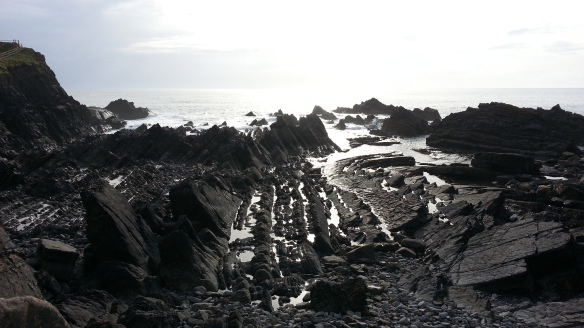
Near Hartland Quay, early June
Day 11 Hartland Quay to Clovelly
Another strenuous day. We followed a solitary figure for a few miles and passed her when she stopped to change into her wet weather gear. Then she passed us as we huddled and fumbled in very heavy rain trying to change into ours. We caught her up at an open air cafe near Hartland Point. It wasn’t open air cafe weather. She was trying to contact her sister in law, whom she was supposed to be meeting there in two hour’s time, to tell her to go straight to Clovelly. We left her there. She caught us up some miles later and we walked together for a bit until she (Caroline, by this time) left us when we stopped for a snack. Then all I remember was relentless rain until the parkland west of the Clovelly estate. The paths had become torrents. We couldn’t have been wetter or tireder. We got to the top of the estate and limped down the Up-Along / Down-Along with its upended cobblestones. We checked in at the New Inn, where we had one of the top rooms and a shared bathroom. Caroline’s sister-in-law Sarah was already there, while Caroline had just arrived having been hoodwinked by paths which looked like rivers and taken a 2-mile detour. In order to dry our stuff we had to rinse off the mud and debris, and then festoon it round the small double room. By then it had brightened up and we walked down to the harbour – the only safe harbour for many miles either side. The village is distinguished by being wholly owned by the local aristocrat, who rents to residents handpicked by interview. Consequently there aren’t any second homes or holiday lets, everybody is resident, and the people are friendly. There are no cars in Clovelly, and heavy stuff is moved by noisy wooden-runnered sleds, these days dragged by men. Had a beanburger at the New Inn – the other pub on the harbour was also lovely and offered finer dining too. Drank a lot of cider and spoke to one of the residents from Peckham. Don’t really remember going to bed.

Clovelly harbour
Day 12 Clovelly to Westward Ho!
This was a very hard day, in lovely weather. It started off in parkland, progressed to woodland, and finally some sea views from clifftop and scrub before the turn along the esplanade into the Victorian town of Westward Ho! The ups and downs were quite arduous, particularly one late one where we dropped about 80 meters to the beach for about 20 steps on boulders before climbing back up higher than we had been. The YHA bunkhouse was unstaffed despite it being after 5. We were exhausted and sweaty so were fairly unsympathetic when the bloke running it sauntered in. After our shower we went out and ended up in The Village Inn, a nice pub where we had dinner (also with Caroline and Sarah). Then Matt and I went for a walk. It’s a very nice place. On the beach at dusk we thought the tide might come in quite fast across the flat beach, but a leaf-shaped formation of posts caught our eye protruding from the sand. Next morning a coastguard told us it was the remains of a ship wreck. Back to the hostel and slept well.

Wrecked boat on Westward Ho! beach, low tide
Day 13 Westward Ho! to Appledore
We had a picnic breakfast and then walked to Appledore along the Westward Ho! beach – tide out, bare feet. Had fun with the blue clay on the beach exposed by the storms, trying to leave footprints to be found by humans in the far future who would analyse them and think we were very fat for our size. Saw a little crab rushing along looking for somewhere to dig, and even a blenny in one of the rockpools. An RNLI lifeguard told us that the oval of wooden stumps at WH!!! was a wreck, again exposed by storms. A woman in Appledore told us they lose sand in winter and gain it back in summer but this year they hadn’t gained what they lost. Funny to live in such a shifting landscape.
Had a good lunch on the terrace of The Beaver Inn. We liked Appledore. From the bus to Barnstaple we could see its massive shipyard – Babcock, on boat #3 for Irish navy.
Then home.


